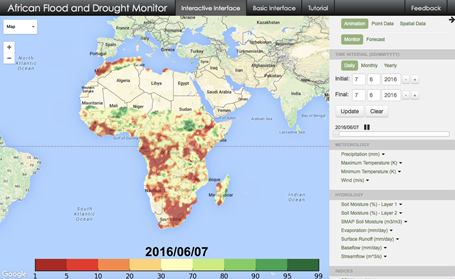Droughts can have serious impacts on agriculture (particularly in developing countries with little irrigation capacity), electricity generation, water resources for domestic consumption, and ecosystems health. These can lead to severe famines, loss of lives, and mass migration. Floods, can also cause loss of lives, damage to infrastructure, and increase the risk of water-borne diseases. Thus, understanding current hydrometeorological conditions and being able to forecast these extremes with as much lead time as possible is critical for stakeholders to be able to able to prepare and act. However, developing countries often have poor climatic services due to lack of infrastructure (including a lack of monitoring hydrometeorological stations), technical expertise, and investments. With the help of satellites, and climate and hydrological models, however, we have been able to expand our study of droughts and floods to these regions. The Terrestrial Hydrology Research Group at Princeton University has developed the Flood and Drought Monitors for Africa and Latin America and the Caribbean (http://stream.princeton.edu), which include monitoring of current conditions, forecasts up to three months, as well as data records back to 1948. This last characteristic is another important feature, given that users can easily access and download the Monitors’ data, allowing them to carry out further analysis.
Chair:
Niels B. Holm-Nielsen, Lead Disaster Risk Management Specialist, GSURR
Presenter:
Julio Herrera-Estrada, Land Surface Hydrology Research Group, Princeton University
Discussant:
Abigail Baca, Infrastructure Specialist, GSURR
Julio Herrera-Estrada is a fourth-year Ph.D. Candidate in Environmental Engineering and Water Resources at Princeton University, also pursuing a graduate certificate in Science, Technology and Environmental Policy at the Woodrow Wilson School of Public and International Affairs. His research focuses on the physical mechanisms that control the evolution of droughts, on how the characteristics of these extreme events might be affected by climate change, and on quantifying their impacts on the Water-Energy Nexus. Julio received his B.S. in Applied Mathematics from Columbia University in 2012 and an M.A. in Civil and Environmental Engineering from Princeton University in 2014. He was born in Mexico City, Mexico where he lived prior to moving the United States for college in 2008.
Calendar » BBL Princeton’s Flood and Drought Monitors for Africa and Latin America and the Caribbean
BBL Princeton’s Flood and Drought Monitors for Africa and Latin America and the Caribbean
The Disaster Risk & Resilience Analytics and Solutions (D-RAS) KSB presents
Princeton’s Flood and Drought Monitors
for Africa and Latin America and the Caribbean
Wednesday, June 15, 2016 | 12:30 – 2:00 PM | Room I 6-170
Click for RSVP and add to calendar
Join Via WebEx
(full details below)
Description:
Droughts can have serious impacts on agriculture (particularly in developing countries with little irrigation capacity), electricity generation, water resources for domestic consumption, and ecosystems health. These can lead to severe famines, loss of lives, and mass migration. Floods, can also cause loss of lives, damage to infrastructure, and increase the risk of water-borne diseases. Thus, understanding current hydrometeorological conditions and being able to forecast these extremes with as much lead time as possible is critical for stakeholders to be able to able to prepare and act. However, developing countries often have poor climatic services due to lack of infrastructure (including a lack of monitoring hydrometeorological stations), technical expertise, and investments. With the help of satellites, and climate and hydrological models, however, we have been able to expand our study of droughts and floods to these regions. The Terrestrial Hydrology Research Group at Princeton University has developed the Flood and Drought Monitors for Africa and Latin America and the Caribbean (http://stream.princeton.edu), which include monitoring of current conditions, forecasts up to three months, as well as data records back to 1948. This last characteristic is another important feature, given that users can easily access and download the Monitors’ data, allowing them to carry out further analysis.
Chair:
Niels B. Holm-Nielsen, Lead Disaster Risk Management Specialist, GSURR
Presenter:
Julio Herrera-Estrada, Land Surface Hydrology Research Group, Princeton University
Discussant:
Abigail Baca, Infrastructure Specialist, GSURR
Join Using WebEx
Meeting number: 736 237 076 | Meeting password: vcKv4MMG
Audio Connection / Call-in numbers
Toll: 1-650-479-3207
Access code: 736 237 076
Global call-in numbers
Event page in GP Portal
(The presentation will be added to this page following the event.)
Please find attached the presentation.
Thanks!